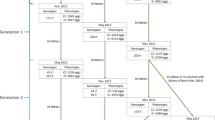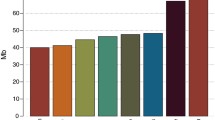Abstract
Background
Genome-editing techniques incorporating artificial nucleases develop rapidly and enable efficient and precise modification of genomic DNA of numerous organisms. The present research aimed to establish a rapid, sensitive and visual method for genotyping of germline genome-edited mutants with small genomic fragment deletion.
Methods and Results
The genome-edited pigs with 2-bp deletion and 11-bp deletion of Myostatin (MSTN) gene generated by TALENs system were used as test materials to check the proposed allele-specific PCR (AS-PCR) and lateral flow nucleic acid biosensor (LFNAB) cascade method. AS-PCR can produce products with different tags to distinguish genome-edited alleles and wild-type alleles. A LFNAB was applied to do visual detection of AS-PCR products without using additional instruments. Furthermore, we demonstrated that AS-PCR and LFNAB cascade could accurately and visually distinguish genome-edited pigs with small genomic fragment deletion of Myostatin (MSTN) gene and wild-type pigs with limit of detection (LOD) of 0.1 ng.
Conclusion
The proposed AS-PCR and LFNAB cascade can do rapid and visual genotyping of genome-edited mutants with small genomic fragment deletion, serving as a platform for genome-edited animal genotyping.




Similar content being viewed by others
References
Urnov FD, Rebar EJ, Holmes MC, Zhang HS, Gregory PD (2010) Genome editing with engineered zinc finger nucleases. Nat Rev Genet 11:636–646
Christian M, Cermak T, Doyle EL, Schmidt C, Zhang F, Hummel A, Bogdanove AJ, Voytas DF (2010) Targeting DNA double strand breaks with TAL effector nucleases. Genetics 186:757–761
Mali P, Aach J, Stranges PB, Esvelt KM, Moosburner M, Kosuri S, Yang L, Church GM (2013) CAS9 transcriptional activators for target specificity screening and paired nickases for cooperative genome engineering. Nat Biotechnol 31:833
Baker M (2012) Gene-editing nucleases. Nat Methods 9:23–26
Wang K, Ouyang H, Xie Z, Yao C, Guo N, Li M, Jiao H, Pang D (2015) Efficient generation of myostatin mutations in pigs using the CRISPR/Cas9 system. Sci Rep 5:16623
Lai L, Kang JX, Li R, Wang J, Witt WT, Yong HY, Hao Y, Wax DM, Murphy CN, Rieke A, Samuel M, Linville ML, Korte SW, Evans RW, Starzl TE, Prather RS, Dai Y (2006) Generation of cloned transgenic pigs rich in omega-3 fatty acids. Nat Biotechnol 24:435–436
Burkard C, Lillico SG, Reid E, Jackson B, Mileham AJ, Ait-Ali T, Whitelaw CB, Archibald AL (2017) Precision engineering for PRRSV resistance in pigs: macrophages from genome edited pigs lacking CD163 SRCR5 domain are fully resistant to both PRRSV genotypes while maintaining biological function. PLoS Pathogens 13:e1006206
Carlson DF, Lancto CA, Zang B, Kim ES, Walton M, Oldeschulte D, Seabury C, Sonstegard TS, Fahrenkrug SC (2016) Production of hornless dairy cattle from genome-edited cell lines. Nat Biotechnol 34:479–481
Yang Z, Steentoft C, Hauge C, Hansen L, Thomsen AL, Niola F, Vester-Christensen MB, Frödin M, Clausen H, Wandall HH, Bennett EP (2015) Fast and sensitive detection of indels induced by precise gene targeting. Nucleic Acids Res 43:e59
Jazayeri SH, Amiri-Yekta A, Bahrami S, Gourabi H, Sanati MH, Khorramizadeh MR (2018) Vector and cell line engineering technologies toward recombinant protein expression in mammalian cell lines. Appl Biochem Biotechnol 185:986–1003
Kim JM, Kim D, Kim S, Kim JS (2014) Genotyping with CRISPR-Cas-derived RNA-guided endonucleases. Nat Commun 6:3292
Ota S, Hisano Y, Ikawa Y, Kawahara A (2014) Multiple genome modifications by the CRISPR/Cas9 system in zebrafish. Genes Cells 19:55564
Cong L, Ran FA, Cox D, Lin S, Barretto R, Habib N, Hsu PD, Wu X, Jiang W, Marraffini LA, Zhang F (2013) Multiplex genome engineering using CRISPR/Cas systems. Science 339:819–823
Dahlem TJ, Hoshijima K, Jurynec MJ, Gunther D, Starker CG, Locke AS, Weis AM, Voytas DF, Grunwald DJ (2012) Simple methods for generating and detecting locus-specific mutations induced with TALENs in the Zebrafish genome. PLoS Genet 8:e1002861
Xing L, Hoshijima K, Grunwald DJ, Fujimoto E, Quist TS, Sneddon J, Chien CB, Bassett AR, Tibbit C, Ponting CP, Liu JL (2013) Highly efficient targeted mutagenesis of Drosophila with the CRISPR/Cas9 system. Cell Rep 4:220–228
Goodwin S, Mcpherson JD, Mccombie WR (2016) Coming of age: ten years of next-generation sequencing technologies. Nat Rev Genet 17:333–351
Hua Y, Wang C, Huang J, Wang K (2017) A simple and efficient method for CRISPR/Cas9-induced mutant screening. J Genet Genom 44:207–213
Mo CH, Cheong WC, Li SL, Li MH (2012) A simple, high sensitivity mutation screening using Ampligase mediated T7 endonuclease I and Surveyor nuclease with microfluidic capillary electrophoresis. Electrophoresis 33(5):788–796
Erali M, Voelkerding KV, Wittwer CT (2008) High resolution melting applications for clinical laboratory medicine. Exp Mol Pathol 85:50–58
Yu S, He L, Yu F, Liu L, Qu C, Qu L, Liu J, Wu Y, Wu Y (2018) A lateral flow assay for simultaneous detection of Deoxynivalenol, Fumonisin B1 and Aflatoxin B1. Toxicon 156:23–27
Cheng N, Xu Y, Huang K, Chen Y, Yang Z, Luo Y, Xu W (2017) One-step competitive lateral flow biosensor running on an independent quantification system for smart phones based in-situ detection of trace Hg(II) in tap water. Food Chem 214:169–175
Xu W, Cheng N, Huang K, Lin Y, Wang C, Xu Y, Zhu L, Du D, Luo Y (2016) Accurate and easy-to-use assessment of contiguous DNA methylation sites based on proportion competitive quantitative-PCR and lateral flow nucleic acid biosensor. Biosensors Bioelectronics 80:654–660
Ge C, Yu L, Fang Z, Zeng L (2013) An enhanced strip biosensor for rapid and sensitive detection of histone methylation. Anal Chem 85:9343–9349
De Souza Sene I, Costa V, Pauli GEN, Bechtold IH, Nunes LCC, Eiras C, Costa CHN (2018) Lateral flow assay for interleukin 6: a technological and scientific prospection of a 10-year survey, recent pat. Biotechnology 12:221–228
Li Z, Wang Y, Wang J, Tang Z, Pounds JG, Lin Y (2010) Rapid and sensitive detection of protein biomarker using a portable fluorescence biosensor based on quantum dots and a lateral flow test strip. Anal Chem 82:7008–7014
Gao X, Xu LP, Wu T, Wen Y, Ma X, Zhang X (2016) An enzyme-amplified lateral flow strip biosensor for visual detection of microRNA-224. Talanta 146:648–654
Gomez-Martinez J, Silvy M, Chiaroni J, Fournier-Wirth C, Roubinet F, Bailly P, Brès JC (2018) Multiplex lateral flow assay for rapid visual blood group genotyping. Anal Chem 90:7502–7509
Anfossi L, D’Arco G, Calderara M, Baggiani C, Giovannoli C, Giraudi G (2011) Development of a quantitative lateral flow immunoassay for the detection of aflatoxins in maize. Food Additives Contaminants: Part A 28:226–234
Cho IH, Bhunia A, Irudayaraj J (2015) Rapid pathogen detection by lateral-flow immunochromatographic assay with gold nanoparticle-assisted enzyme signal amplification. Int J Food Microbiol 206:60–66
Chen J, Wen J, Zhuang L, Zhou S (2016) An enzyme-free catalytic DNA circuit for amplified detection of aflatoxin B1 using gold nanoparticles as colorimetric indicators. Nanoscale 8:9791–9797
Zou Z, Du D, Wang J, Smith JN, Timchalk C, Li Y, Lin Y (2010) Quantum dot-based immunochromatographic fluorescent biosensor for biomonitoring trichloropyridinol, a biomarker of exposure to chlorpyrifos. Anal Chem 82:5125–5133
Choi JR, Hu J, Tang R, Gong Y, Feng S, Ren H, Wen T, Li X, Wan Abas WA, Pingguan-Murphy B, Xu F (2015) An integrated paper-based sample-to-answer biosensor for nucleic acid testing at the point of care. Lab Chip 16:611–621
Cheng N, Wang Q, Shang Y, Xu Y, Huang K, Yang Z, Pan D, Xu W, Luo Y (2018) Rapid and low-cost strategy for detecting genome-editing induced deletion: a single-copy case. Anal Chim Acta 101:111–118
He Y, Zeng K, Zhang S, Gurung AS, Baloda M, Zhang X, Liu G (2012) Visual detection of gene mutations based on isothermal strand-displacement polymerase reaction and lateral flow strip. Biosens Bioelectron 31:310–315
Waterfall CM, Cobb BD (2001) Single tube genotyping of sickle cell anaemia using PCR based SNP analysis. Nucleic Acids Res 29:e119
Newton CR, Graham A, Heptinstall LE, Powell SJ, Summers C, Kalsheker N, Smith JC, Markham AF (1989) Analysis of any point mutation in DNA. The amplification refractory mutation system (ARMS). Nucleic acids research 17:2503–2516
He Q, Chen M, Lin X, Chen Z (2020) Allele-specific PCR with a novel data processing method based on difference value for single nucleotide polymorphism genotyping of ALDH2 gene. Talanta 220:121432
Kang JH, Yu KH, Park JY, An CM, Jun JC, Lee SJ (2011) Allele-specific PCR genotyping of the HSP70 gene polymorphism discriminating the green and red color variants sea cucumber (Apostichopus japonicus). J Genet Genomics 38:351–355
Trimmer K, Arur S (2021) CRISPR-edit point mutant allele detection (CEPAD)-PCR method for rapid screening of CRISPR edited point mutations. Micro Publication Biology. https://doi.org/10.17912/micropub.biology.000368
Yu C, Zhang Y, Yao S, Wei Y (2014) A PCR based protocol for detecting indel mutations induced by TALENs and CRISPR/Cas9 in zebrafish. PLoS ONE 9:e98282
Bell CC, Magor GW, Gillinder KR, Perkins AC (2014) A high-throughput screening strategy for detecting CRISPR-Cas9 induced mutations using next-generation sequencing. BMC Genomics 15:1002
Hendel A, Fine EJ, Bao G, Porteus MH (2015) Quantifying on-and off-target genome editing. Trends Biotechnol 33:132–140
Findlay SD, Vincent KM, Berman JR, Postovit LM (2016) A digital PCR-based method for efficient and highly specific screening of genome edited cells. PLoS ONE 11:e0153901
Acknowledgements
This work was supported by the National Natural Science Foundation of China (31802040 and 32172699).
Author information
Authors and Affiliations
Contributions
QS, XZ and BL conceived of the AS-PCR and LFNAB cascade method. QS performed the experiments. TW and KL contributed materials. QS and XZ wrote the manuscript. XZ, LB, WX, ZL, and PS edited the manuscript.
Corresponding author
Ethics declarations
Conflict of interest
The authors declare that they have no conflicts of interest.
Ethical approval
Not applicable.
Consent to participate
Not applicable.
Consent to publication
Not applicable.
Additional information
Publisher’s Note
Springer Nature remains neutral with regard to jurisdictional claims in published maps and institutional affiliations.
Supplementary Information
Below is the link to the electronic supplementary material.
Rights and permissions
About this article
Cite this article
Su, Q., Zhou, X., Wu, T. et al. Rapid visual genotyping method for germline mutants with small genomic fragment deletion by allele-specific PCR and lateral flow nucleic acid biosensor. Mol Biol Rep 48, 7325–7332 (2021). https://doi.org/10.1007/s11033-021-06734-x
Received:
Accepted:
Published:
Issue Date:
DOI: https://doi.org/10.1007/s11033-021-06734-x




